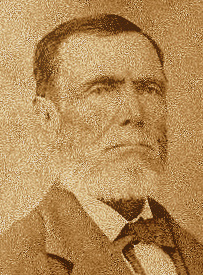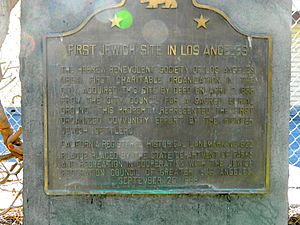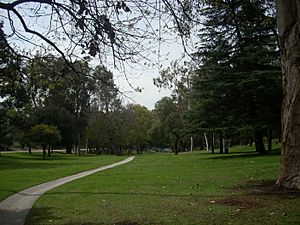Chavez Ravine facts for kids
Chavez Ravine is a valley in Los Angeles, California. It is located in the hills north of downtown Los Angeles, right next to Major League Baseball's Dodger Stadium. The ravine was named after Julian A. Chavez, a Los Angeles councilman from the 1800s. He was one of the first people to own land in the Elysian Park area.
Contents
History of Chavez Ravine
The 1800s

Chavez Ravine got its name from Julian Chavez, who was the first known owner of the land. He was born in New Mexico and moved to Los Angeles in the early 1830s. He quickly became an important local leader. In 1844, Chavez bought about 83 acres of this long, narrow valley. We don't have many records of what Chavez did with his land. However, during the 1850s and 1880s, when many people got sick from diseases like smallpox, Chavez Canyon had a special "pest house." This was a place where sick people were cared for.
The area also had an early Jewish community starting in the 1850s. The first Jewish cemetery in Los Angeles was in Chavez Ravine. It opened in 1855 and was owned by the Hebrew Benevolent Society of Los Angeles. This group was a Jewish charity, and it was also the first charity in Los Angeles. They bought 3 acres of land for the cemetery for just $1 from the city. The Hebrew Benevolent Society was started in 1854 to find a burial ground for people of their faith and to help others. The city gave them the land on April 9, 1855. This first Jewish cemetery was located where Dodger Stadium and the Los Angeles Fire Department's Frank Hotchkin Memorialized Training Center are today.
The land in Chavez Ravine was very rough, which made it hard to build on at first. But the area was important for water. The Los Angeles Water Company used part of it for a canal. This canal brought water from what is now Griffith Park and stored it in a reservoir. Some of Chavez Canyon and the nearby hills became Elysian Park in 1886. That same year, two companies that made bricks started working in Chavez Ravine. They began blasting in the hillsides.
The 1900s

In 1902, the Jewish cemetery in Chavez Ravine was moved. This happened because of pollution from the growing oil industry in the area. The buried remains were moved to a new site in East LA. This new place became the Home of Peace Cemetery.
By the early 1900s, a community of Mexican-American families had grown in the hills around the ravine. Eventually, three neighborhoods formed: Palo Verde, La Loma, and Bishop. In 1913, a lawyer named Marshall Stimson helped about 250 Mexican-American families move to these communities. They moved from an area near the Los Angeles River that often flooded. The neighborhoods had a local grocery store, a church, and Palo Verde Elementary School. There was also a brick factory nearby, which caused problems with smoke and dust. In 1926, the people living in Chavez Ravine worked together to shut down the factory. On August 20, 1926, the Los Angeles City Council voted to stop the blasting. They also decided that the area around Chavez Ravine should only be used for homes.
The 1940s
Chavez Ravine was home to three main Mexican-American communities: La Loma, Palo Verde, and Bishop.
In the 1940s, this area was a poor but close-knit community. Many families lived there because of housing discrimination in other parts of Los Angeles. As Los Angeles grew, Chavez Ravine was seen as a good place for new development. The city started to call the area "blighted," meaning it looked run-down and needed new construction. The Housing Authority of the City of Los Angeles was given the job to build public housing. They used money from the government to help with the big housing shortage after World War II. Famous architects Richard Neutra and Robert Alexander made a plan for a project called "Elysian Park Heights." The city had already moved many residents out of Chavez Ravine when the whole project suddenly stopped.
The 1950s
The land for Dodger Stadium was bought from local owners in the early 1950s by the City of Los Angeles. They used a process called eminent domain. This means the government can buy private land for public use, even if the owners don't want to sell. The city had planned to build the Elysian Park Heights public housing project there. This project was supposed to have many tall buildings and townhouses, plus new playgrounds and schools.
Author Mike Davis wrote about how the city slowly convinced homeowners in Chavez Ravine to sell. He said that most Spanish-speaking homeowners didn't want to sell at first. So, "developers" working for the city offered cash payments through Spanish-speaking agents. Once some sales were made, remaining homeowners were offered less money. This was done to make people worried they wouldn't get fair payment, or that they would be left as the only ones still there. Some residents kept fighting, even with all the pressure. This led to the Battle of Chavez Ravine. This was a ten-year struggle by a few remaining families to keep their homes. Most of the area had already been taken over by the city.
Before the Elysian Park Heights project could start, the local government changed. Norris Poulson was elected mayor of Los Angeles in 1953. Poulson was against public housing. He said it was "un-American." So, support for projects like Elysian Park Heights disappeared. After long talks, the City of Los Angeles was able to buy the Chavez Ravine property back from the government at a much lower price. The rule was that the land had to be used for a public purpose.
After a public vote called the "baseball referendum" in 1958, the city made a big decision. They traded 352 acres of land at Chavez Ravine to the Brooklyn Dodgers and their owner, Walter O'Malley. In return, the city got land around a minor league baseball park called Wrigley Field. This trade was meant to encourage the Dodgers to move to Los Angeles. The Dodgers played their home games at the Los Angeles Memorial Coliseum from 1958 until 1961. Dodger Stadium officially opened in 1962.
Later Years
From 1962 to 1965, the Los Angeles Angels also played at Dodger Stadium. During those years, the Angels called it "Chavez Ravine Stadium." In October 2008, the Los Angeles City Council named the property "Dodgertown." The United States Postal Service even gave it its own postal code, "Dodgertown, CA 90090," in April 2009.
Some buildings from Chavez Ravine were saved from being torn down. The people who built Dodger Stadium sold them to Universal Studios for just one dollar each. Universal moved these buildings to its movie set. They later appeared in different movies, like the 1962 film To Kill a Mockingbird. For example, the house of Atticus Finch in the movie was once a home in Chavez Ravine.
Chavez Ravine Today
Most of Chavez Ravine is still part of Elysian Park. The Chavez Ravine Arboretum is still there. This arboretum was started in 1893. Trees were added to it until the 1920s. Many of the original trees are still standing. Some are the oldest and largest of their kind in California and even the United States. Further south in the ravine is Barlow Respiratory Hospital. It was founded in 1902 and still helps patients today. At the end of the ravine, right next to Dodger Stadium, is the Naval and Marine Corps Reserve Center. It was built in 1937. Today, it is a training center for the Los Angeles City Fire Department, called the Frank Hotchkin Memorial Training Center.



